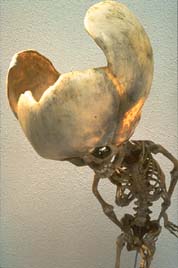 Jim Jarmusch, John Yau, and Harold Schechter
Jim Jarmusch, John Yau, and Harold Schechter
Heck Editions ($29.95)
by Brian Evenson
With forty-three color plates, numerous black and white images, and essays by filmmaker Jim Jarmusch, art critic John Yau, and cultural critic Harold Schechter, Original Sin is a strong introduction to Joe Coleman's painting. In work that owes something to altar pieces, investigations of skin disease, l'art brut, and creep shows, Coleman creates a highly visceral and disturbing art which plunges so deeply into the subconscious that it is difficult for the viewer to resurface.
Many of Coleman's paintings focus on historical figures who are literal or symbolic outsiders. These range from the seemingly benign, such as Houdini, Jayne Mansfield, Sigmund Freud, and musician Hasil Adkins; to artists associated with madness and excess, such as Edgar Allen Poe, L.-F. Céline, and Adolf Wölfli; to serial killers such as Carl Panzram, Charles Manson, Albert Fish, and Ed Gein. These portraits are surrounded by quotations from or about the figure and by small related images and scenes, often grotesque. The paintings demand to be read and explored. By doing so, the viewer enters a world, for instance, where a small image of Ed Gein pulling a body across the snow has a remarkable resemblance to a Currier & Ives winter scene.
John Yau sees such paintings as Coleman finding historical counterparts for his id, thus establishing a "dissonant, lyric 'I.'" This strikes me as a much more effective reading of Coleman than Harold Schechter's more predictable attempt to fit Coleman into a Jungian model of archetypes. Indeed, part of the reason Coleman's paintings work is that the figures he presents remain palpable and real, irreducible; even as they create an "I" for Coleman, they remain schizophrenic, an assemblage of horrors all speaking in their own voices.
In works such as Divine Comedy and Immaculate Conception, Coleman explores groups of often grotesque figures in ways that recall Bosch, Brueghel, Otto Dix, and others. At least as intriguing are the paintings closer to Coleman himself, images like Mommy/Daddy, which explore Coleman's conflicted relationship to his mother and father, or the disturbing self- portrait Auto-Autopsy, in which Coleman's eye is being pried out while creatures made of genitalia cavort below.
Acknowledging the strong connections between his personal life and his art, Original Sin also offers a portrait of Coleman the man. In an index, the portraits are keyed, with interpretations provided for some of the images. As a person, Coleman is, to say the least, an odd duck. He used to fake being a beggar. He bit the heads off mice in public performance (much to Bob Barker's dismay), and broke into strangers' houses to play the exploding man by lighting off fireworks hidden under his shirt. He keeps an "Odditorium" (full tour included in Original Sin), which Jarmusch calls "one of the world's greatest collections of extremely weird shit." It contains such goodies as a fetus named Junior, paintings by serial killer John Wayne Gacy, a reliquary containing a piece of Jesus, a lock of Charles Manson's hair, the death cast of Vincent Price's face, and two mummified Fijian mermaids.
Not for the faint of heart, Coleman's art is nevertheless the real thing, exploring a space few others dare to touch. Likely to appeal to comix aficionados, carny lovers, and art enthusiasts alike (though in quite different ways), Coleman's art rubs right up against the raw nerves of the viewer's own subconscious, sparking a sense of reaction and recognition even as it insists on its extreme otherness.
Rain Taxi Print Edition, Vol.3 No. 1, Spring (#9) | © Rain Taxi, Inc. 1998




